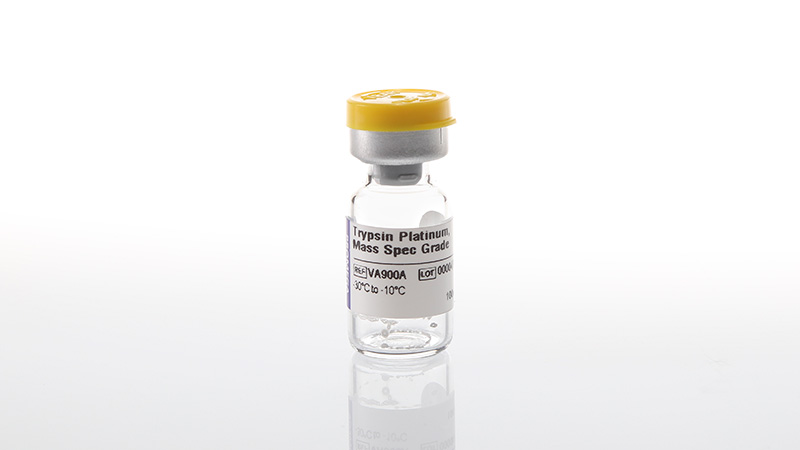인류의 건강과 생명공학 발전을 위해 봉사하는 기업 드림셀
We Serving the Health and Biotechnology of Humanity
We Serving the Health and Biotechnology of Humanity

제품코드 : VA9000
제품정보 : Protease
Commercially available proteomic and mass spec grade trypsin products contain nonspecific protease activity at a low but detectable level. Close analysis of this activity suggests it is chymotryptic in nature. The nonspecific, chymotryptic-like cleavage activity becomes evident if large amounts of trypsin are used in a digestion reaction (Figure 1, Panel A). These nonspecific cleavage activities compromise the quality of protein analysis. Our production procedure assures that Trypsin Platinum is free of any detectable traces of nonspecific cleavage activity (Figure 1, Panel B).
Autoproteolysis is another common negative side effect of trypsin digestion. To suppress trypsin autoproteolysis, trypsin used in protein mass spec sample preparation is chemically modified. Yet, a certain level of autoproteolysis is still observed (Figure 2, Panel A). The generated tryptic autoproteolytic peptides often compromise protein analysis, particularly if a large amount of trypsin is used in a digestion reaction. Our novel modification method further suppresses Trypsin Platinum autoproteolysis compared to the autoproteolysis observed in the currently available proteomic and mass spec grade trypsin products (Figure 2, Panel B), assuring that the level of autoproteolytic tryptic peptides remains negligibly low even if large quantities of Trypsin Platinum are used.

Figure 1. Comparison of nonspecific proteolytic activity between Trypsin Platinum and trypsin from another supplier. Panitumumab (Vectibix®) was used as a model protein substrate. The digestion reactions used a 1:10 trypsin:protein ratio. Digested peptides were analyzed with RP-HPLC-UV. The peptide peaks were assigned with LC-MS to differentiate between specific and nonspecific peptides. Analysis showed that mass spec grade trypsin from vendor T (used for comparison) contains prominent nonspecific proteolytic activity (Panel A). Close analysis indicated a chymotryptic-like pattern of the generated nonspecific cleavages (data not shown). In contrast, Trypsin Platinum generated specific tryptic cleavages only (Panel B).

Figure 2. Comparison of autoproteolytic activity between Trypsin Platinum and proteomic-grade trypsin from another supplier. Proteomic grade trypsin from vendor S (used for comparison) and Trypsin Platinum were incubated at conventional digestion conditions. Specifically, trypsin products were reconstituted in 100mM Tris-HCl (pH 8)/2mM CaCl2 and incubated overnight at 37°C. Autoproteolytic products were analyzed with RP-HPLC-UV. Fresh, nonincubated aliquots of either trypsin were analyzed as a control. Proteomic grade trypsin demonstrated prominent autoproteolysis, whereas autoproteolysis of Trypsin Platinum was reduced to a negligible level (compare Panels A and B).
아래 링크를 클릭하시면 제품에 대한 자세한 정보를 확인하실 수 있습니다.
Trypsin Platinum, Mass Spectrometry Grade Technical Manual, TM654